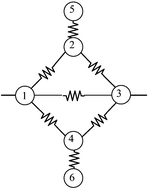We present a compact model describing the laminar flow of viscous multiphase fluids in micro-channel networks. We apply this model to the flow of 2 immiscible fluids representing typically oil and water, in a network of micro-channels comprising one inlet for each fluid splitting into 2 branches meeting at a T-junction, where the 2 phases are combined before exiting the network through two outlets. This network is akin to an electrical “Wheatstone bridge” and represents a simplified interdigital micro-reactor, where the fluids to be mixed are separated into smaller branches and later re-combined together. We show from an analytical solution and a computational modelling that fluid flow inside this network is very sensitive to small differences in fluid resistance between the various branches of the network, which may lead to catastrophic error in fluid distribution between the various branches that can have a profound effect on mixing. These errors depend on the viscosity difference between the fluids, on the processing conditions, and also on the geometric resistance parameters of the various channels. Increasing the resistance of the distribution channels upstream of the fluid junctions allows minimisation of the distribution errors. Interaction between the fluids can also lead to transients that are orders of magnitude longer than the flooding time of the channels. This may be exploited to provide impedance-like terms in flui-logic operations.

You have access to this article
 Please wait while we load your content...
Something went wrong. Try again?
Please wait while we load your content...
Something went wrong. Try again?


 Please wait while we load your content...
Please wait while we load your content...